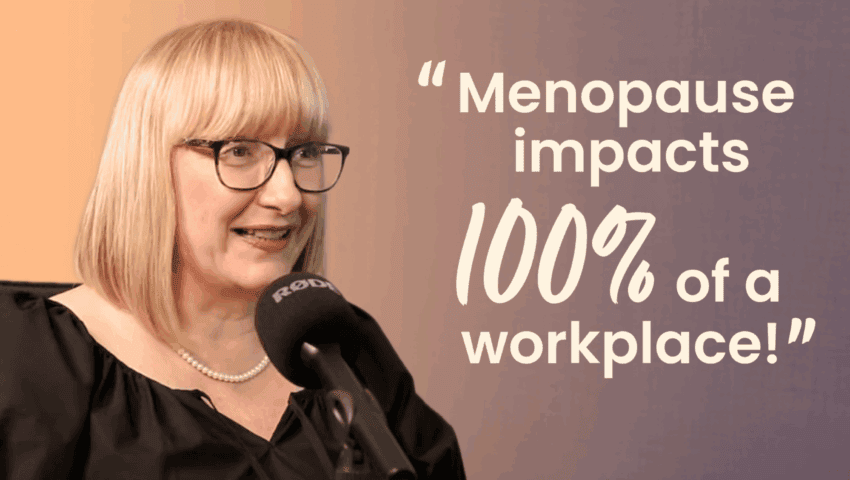Blogs
Menopause at work, what really helps and why it matters

“Menopause impacts 100% of a workplace, directly or indirectly.” — Tracey Allport, Menopause Expert
Menopause is not only a women’s issue. It touches teams, relationships, performance, and culture. For World Menopause Day (18 October), here are distilled insights from our Lunch at Work podcast with menopause expert Tracey Allport. You’ll find practical guidance on symptoms, support, and the small changes that help everyone.
Meet the expert
Tracey Allport is a menopause specialist and occupational therapist with more than 32 years of experience. After navigating her own perimenopause, she retrained in the approaches that helped her most and now supports individuals and organisations with practical, holistic guidance.
Perimenopause, menopause, post-menopause — what’s the difference?
Perimenopause is the transition period before menopause when symptoms often begin because hormones fluctuate.
Menopause is defined retrospectively as 12 consecutive months without a menstrual period.
Post-menopause is every day after that one-day menopause milestone.
Hormone receptors exist throughout the body, so symptoms can vary widely and change over time.
Common symptoms and why they vary
Tracey groups symptoms into three broad areas:
-
Physical: migraines, joint aches and pains, itchy or reactive skin, changing allergies.
-
Psychological: low mood, anxiety, decreased confidence, loss of sense of self, sleep disturbance.
-
Somatic: pain or internal sensations that affect how you experience your body day to day.
“It does not always hit. It can build. Fluctuating hormones chip away at sleep, resilience, and stress tolerance, which then impacts confidence and performance.”
Confidence and performance at work
Poor sleep and lower progesterone, a naturally calming hormone, can leave people feeling more reactive, frustrated, and overwhelmed. That’s not a skills issue, it’s physiology. Small, thoughtful adjustments can prevent a spiral and keep great people thriving.
First steps for individuals
-
Track your cycle and symptoms. Notice pattern changes such as shorter or heavier cycles and sleep shifts.
-
Use a structured tool. The Green Climacteric Scale can help baseline and monitor key symptoms over time.
-
Log work impact. Note which tasks and times are hardest. This supports targeted adjustments.
If you manage people, use the 3 Cs
-
Curiosity: Start with open questions and an assumption of good intent.
-
Communication: Create a safe, stigma-free space for ongoing dialogue.
-
Compassion: Co-design adjustments. Aim for thoughtful, person-centred tweaks.
“Team members do not always want ready-made solutions. They want understanding and help shaping workable options.”
Why this matters: retention, culture, and cost
-
1 in 6 women leave work due to menopause difficulties.
-
Replacing experienced talent is costly — independent analysis suggests replacement costs can exceed £300k for some roles.
-
The 50–64 age bracket is a major growth area for the workforce. This is experience you can’t afford to lose.
Go beyond a policy
Policies are essential, but culture and practical support do most of the work.
-
Include menopause in your inclusion and wellbeing strategies.
-
Offer flexible working options such as temporary start time changes or remote work where feasible.
-
Tailor role-specific adjustments using a simple individual needs or risk assessment.
-
Provide training and awareness for managers and teams.
-
Create peer networks and mentors plus informal spaces for conversation.
-
Signpost clearly to internal and external support.
“Make it real” is the goal. Ask how your policy translates into an individual day at work.
If you don’t feel able to talk to your manager
It happens. 4 in 10 women don’t raise menopausal symptoms with a line manager because of fear, stigma, or worries about career impact. Alternatives include:
-
Speak confidentially with HR.
-
Contact a menopause advocate or champion if your organisation has one.
-
Use your symptom data to guide the conversation when you’re ready.
HRT in brief
Hormone Replacement Therapy (HRT) is a first-line clinical option for many menopausal symptoms. It’s not suitable or preferred by everyone, and choice should be respected.
Lifestyle still matters with or without HRT:
-
Prioritise sleep routines and moderate alcohol.
-
Add strength training two to three times per week plus regular cardio for bone, heart, and mood.
-
Don’t ignore smoking risks, which increase after menopause.
-
See your GP for assessment and blood tests (thyroid, vitamin D, B12, iron or ferritin). Deficiencies can mimic or amplify symptoms.
This article is for information only and is not medical advice. Please consult a qualified healthcare professional for diagnosis and treatment.
The upside: purpose, clarity, and renewed momentum
Menopause is a transition, not an ending. After the unsettled period, many people report:
-
A stronger sense of self and purpose
-
Sharper focus and renewed energy
-
A desire to mentor others and support the next wave
“Perimenopause can be a chance to pause. Reflect, recalibrate, and set the next third of your life with intention.”
Quick checklist for team members
-
Track symptoms such as with the Green Climacteric Scale.
-
Capture work impact patterns including time of day and task types.
-
Try small habit shifts such as sleep routine, caffeine and alcohol timing, and resistance training.
-
Speak with your GP about options including HRT and non-HRT.
-
Choose a first conversation: line manager, HR, or a menopause champion.
-
Ask for one or two specific adjustments to trial for four to six weeks.
Quick checklist for team managers
-
Include menopause in your EDI and wellbeing strategy.
-
Provide manager training and team education.
-
Offer flexible options such as start times, remote days, and break patterns.
-
Use individual assessments to tailor adjustments.
-
Set up a peer network or mentors and clear signposting.
-
Measure outcomes such as retention, absence, and pulse surveys, then iterate.
A final word from Tracey
“We are going in the right direction. The more we talk, the easier it gets. No one has to suffer in silence.”
About the podcast guest
Tracey Allport, menopause expert and occupational therapist, supports individuals and organisations with education and practical, holistic strategies for menopause at work.
Listen to Tracey’s full podcast here





